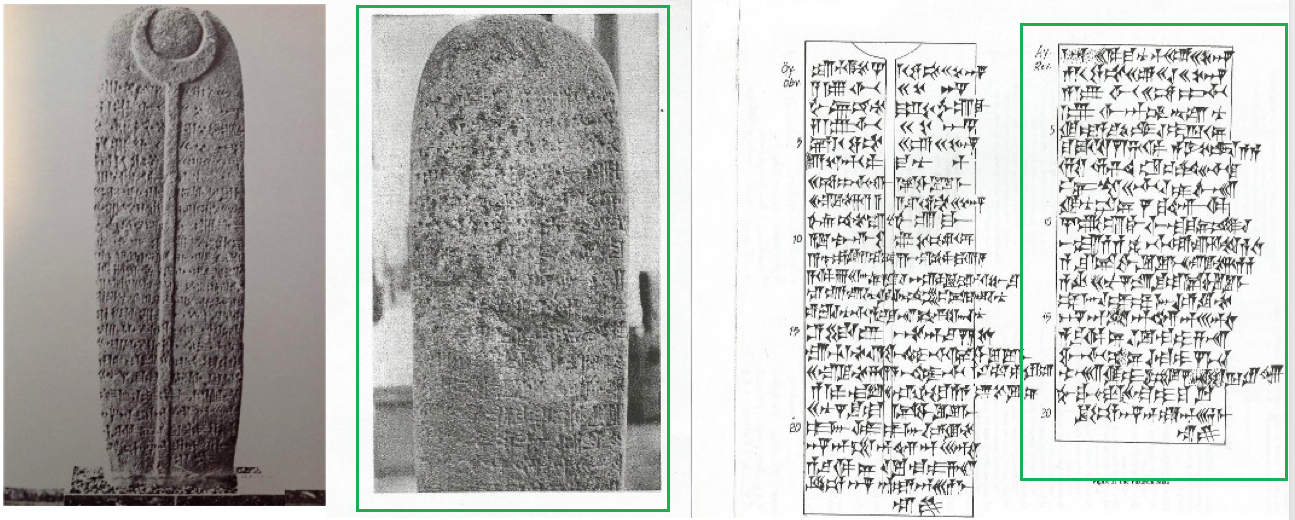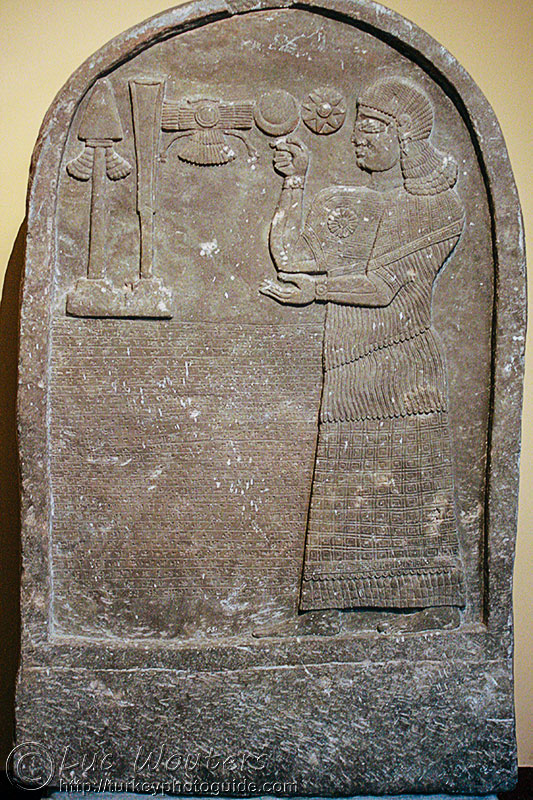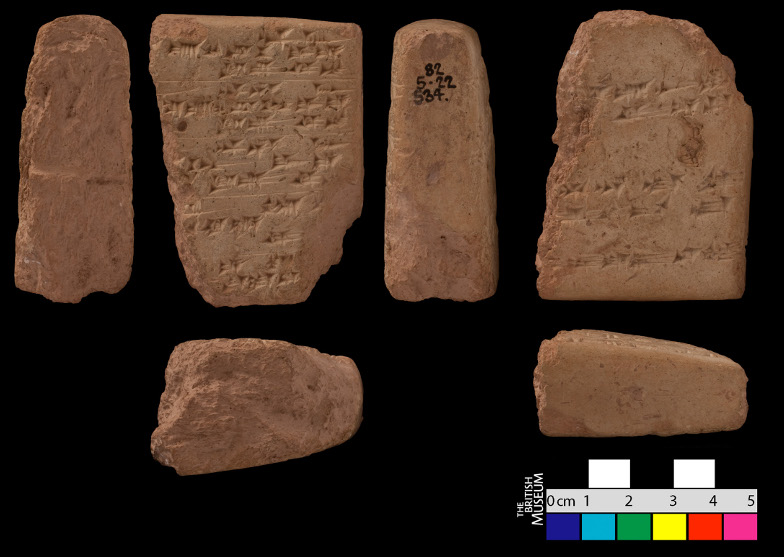Shalmaneser IV
Go to:
Introduction
Go to: Texts
Introduction
After a relatively long reign of twenty-eight years, Adad-nārārī III was succeeded by three of his sons, all of whom are poorly attested in royal inscriptions. For the first of these, Shalmaneser IV (782-773 BC), only two royal inscriptions are preserved, along with a fragmentary decree and a fragmentary letter to the god Aššur which may come from his reign. Nonetheless, the eponym chronicle [/saao/Q007771.86/] is well-preserved for this reign and attests to yearly campaigns, mainly to Urartu in the north, but also to the south and west.
The prominent role of officials in the exercise of power in the Assyrian empire continued during Shalmaneser IV's reign. This is clearly attested in a monumental inscription incised on two lions from Til-Barsip/Kar-Shalmaneser, the provincial capital of the field marshal Šamši-ilu (Adad-nārārī III text no. 2010). This is a fairly typical display inscription, except that the king of Assyria is not mentioned, but rather Šamši-ilu himself. After a listing of deities with their epithets, the name, epithets, and extent of conquest of Šamši-ilu are presented. This is followed by an account of his campaign against Argišti I [/ecut/urartianrulersandtheirinscriptions/argitiisonofminuaa8andb8/index.html] of Urartu. According to the account, Argišti rebelled, so Šamši-ilu went to battle at the command of Aššur and Ninlil. Having defeated Urartu, he set up the monumental lions at the gate of his city. The themes and literary shape of this inscription are very like those of typical display inscriptions of Assyrian kings.
Šamši-ilu appears in a second inscription from the time of Shalmaneser IV, which is incised on the reverse of the Pazarcık Stele (text no. 1). The obverse of that monument bears an inscription of Adad-nārārī III and his mother, Sammu-ramat, and recounts how they were called out to defend an ally, Ušpilulume, and how they established a boundary for him (Adad-nirari III text no. 3). The reverse of the Pazarcık Stele bears an inscription which begins with the name, epithets, and patrilineage of Shalmaneser IV, then recounts how Šamši-ilu went on a campaign to Damascus and received its tribute. Afterward he (Šamši-ilu or Shalmaneser IV?) gave the boundary stone to Ušpilulume, presumably honoring the boundary fixed by Adad-nārārī III and Sammu-ramat.
Together, these two inscriptions reveal that Šamši-ilu retained and possibly increased in power relative to the king of Assyria during the reign of Shalmaneser IV, reflecting a decentralization of Assyrian power during the first half of the eighth century. Indeed, this reality was not limited to the office of Šamši-ilu. His colleague Bel-Ḫarran-beli-uṣur, the palace herald later in the reign of Shalmaneser IV, also produced his own monumental inscription on the Tell Abta Stele (text no. 2). The structure of this inscription is not unlike that of Šamši-ilu's Til-Barsip inscription, but the list of deities are said to have commanded Bel-Ḫarran-beli-uṣur to build a city in the desert, which he named after himself, Dur-Bel-Ḫarran-beli-uṣur, a common practice among Assyrian kings. He then erected a stele with his inscription in the city's temple and established exemption from taxation for the city. Strikingly, Bel-Ḫarran-beli-uṣur was originally called the palace herald of Shalmaneser IV in this inscription, but that king's name was erased and replaced with that of Tiglath-pileser III [/rinap/rinap1]. Bel-Ḫarran-beli-uṣur was clearly palace herald for a time during the latter part of the reign of Shalmaneser IV, then was replaced, as indicated by the eponym chronicle's entry for the year 751 [/saao/Q007771.118/], and was reinstalled in this role during the reign of Tiglath-pileser III, according to the eponym chronicle entry for 741 [/saao/Q007771.131/]. The politics of this period are complex, and much, unfortunately, is obscured by the dearth of historical sources.
Bibliography
Browse the RIAo Corpus [http://oracc.museum.upenn.edu/riao/pager/]
Texts
1 - Pazarcık Stele

KMT -. © Anadolu Yazıları [https://anatolianscripts.com/script/pazarcik-steli/]
A stone stele (140 x 44 x 16.5 cm) found in a village Kızkapanlı, close to modern Maraş, during the construction of the Pazarcık dam, bears an inscription recording the establishment of a border between the states of Kummuḫ and Gurgum. The obverse of the stele is engraved with an inscription of Adad-nārārī III (text no. 3). The text on the reverse, edited here, is a confirmation of the one on the obverse, recording the same border of Ušpilulume, king of Kummuḫ. An unusual characteristic of this text is the predominant role credited to Šamšī-ilu, the turtānu or filed marshal, that already at the time of Adad-nārārī III has a prominent part in the political landscape of the western part of Assyria (see Adad-nārārī III texts nos. 2010 and 2011). The inscription was written on the return from the campaign against Damascus in 773 BC. Notably, the text ends with curses on anyone who would violate the border.
Access the composite text [http://oracc.museum.upenn.edu/riao/Q006687/] of Shalmaneser IV 01.
Bibliography
2

Ist 01326. © Luc Wouters
A stone stele discovered at Dūr-Bēl-Ḫarran-bēlī-uṣur/Tell Abta on the Wadi Tharthar, between Hatra and Tell Afar. On the upper part of the stele the symbols of the gods quoted in the text below are engraved, while on the right side is visible the profile of a standing human figure, most probably the palace herald Bēl-Ḫarran-bēlī-uṣur (see the introduction to Adad-nārārī III) who is also the author of the inscription. In the text, the official records the foundation of a city, under the command of the king. Two notable features of the inscription are that the king's name was originally that of Shalmaneser IV, but it was later erased and substituted with the one of Tiglath-pileser III, and that the palace herald takes personally the credit for having built the city from top to bottom and to have written the royal inscription; a fact that underlines the degree of independence reached by this official.
Access the composite text [http://oracc.museum.upenn.edu/riao/Q006688/] of Shalmaneser IV 02.
Bibliography
3 - Letter to the God

1882-05-22, 0534; cdli P463965 [https://cdli.ucla.edu/dl/photo/P414139.jpg] © The Trustees of the British Museum
A clay tablet bears the beginning and the end of a "Letter to the God" text, of the same typology of the more famous Sargon II's Letter to God Aššur, with which shares various similarities. Like Sargon's text, this inscription begins with greeting formulae to the god Aššur and other deities, and a declaration that everything is well with the king and his army, according to the well-known Neo-Assyrian epistolary style. Like Sargon's composition, the letter ends (the whole central part with the narration of the military undertakings being missed) with a statement about the soldiers killed during the campaign. This list is identical with the one at the end of Sargon's letter, a fact that – together with the scarce number of Assyrian casualities – points to a symbolic formula, rather than to an actual report.
Access the composite text [http://oracc.museum.upenn.edu/riao/Q006689/] of Shalmaneser IV 03.
Bibliography
1001
A large clay cone found at Ashur is inscribed with a fragmentary nineteen lines text of which only the beginning of each line is visible, although not readable. Grayson (RIMA 3, p. 244) ascribes this inscription to Shalmaneser IV or Aššur-dan III on the basisi of lines 1' and 2', which might read mšá> [>l>(?)-...] m10(?)-[...].
Access the composite text [http://oracc.museum.upenn.edu/riao/Q006690/] of Shalmaneser IV 1001.
Bibliography
J. Caleb Howard & Nathan Morello
J. Caleb Howard & Nathan Morello, 'Shalmaneser IV', The Royal Inscriptions of Assyria online (RIAo) Project, The RIAo Project, a sub-project of MOCCI, 2020 [http://oracc.museum.upenn.edu/riao/theassyrianempire883745bc/shalmaneseriv/]